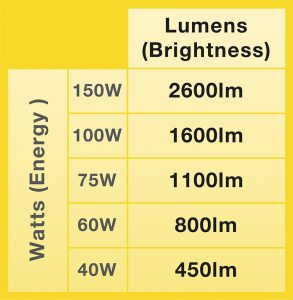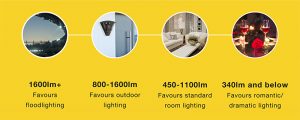When comparing different light bulbs, most people look at wattage as a measure of brightness. However, due to the widespread adoption of LED technology, this unit of measurement is becoming less and less relevant; now, it’s all about the lumens.
So what are ‘lumens’?
Lumens are defined as “a unit of luminous flux in the International System of Units, that is equal to the amount of light given out through a solid angle by a source of one candela intensity radiating equally in all directions“. Great, but what does that actually mean? Put simply, lumens measure the total amount of light produced by a light source; in other words, the brightness of the light.
Lumens Vs. Watts
Watts measure the amount of energy that is used by a light bulb to produce light. However, with bulbs becoming more energy efficient, this measurement does not always provide an accurate steer on levels of brightness. And then when you consider that the sole purpose of a light bulb is to illuminate an area, it makes perfect sense to compare different bulbs based on the level of light they produce – and not the energy they use.
Low energy LED bulbs, for example, are able to produce a higher light output without using as much power; a 6.5W LED bulb will give a similar light output to a 50W halogen bulb! In this scenario, if you were comparing the wattages of both bulbs you would think the halogen bulb was far brighter due to the higher wattage, however this is not the case.
As helpful pointer, many LED bulbs come with an equivalent watt specification that make it easier to compare ‘old’ bulbs with ‘new’ ones; however, remember that this is only an approximate comparison.

A technical point: lumens and useful lumens
When comparing lumens levels, it is important to understand that they are measured differently across the various styles of bulbs. When measuring lumens for non-directional bulbs such as globe, golfball, or candle shaped bulbs, the lumens output is measured in all directions. However, with directional bulbs, such as spotlights, some of the light produced may be ‘wasted’, but is still counted in the total lumens rating.
To allow for an easier comparison between bulbs, a useful lumens rating was introduced. This rating only measures light that is released in a 90° cone from the centre of the bulb, ignoring any spilt or ‘wasted’ light. When comparing the lumens rating vs. the useful lumens rating, you will notice that the useful lumens rating is lower. However, this measurement is far more accurate for spotlights as the light is only emitted in one direction.
Hmm. How many lumens do I need?
Each room around your home will have its own lighting needs, and therefore varying levels of lumens will be required in order to achieve your desired lighting effects. Unfortunately, there isn’t an exact science around the number of lumens required as the room size, ceiling height, and colour scheme will all impact the number of lumens needed in each room. For example, a large room with a high ceiling and dark walls will require a higher number of lumens compared to a smaller, lighter room.
As a useful steer, take a look at this cheat sheet:

For the energy conscious among us, wattage will always be an important measurement of how energy efficient a bulb is. However, if you want a true understanding of how bright your bulb will be, then make sure you keep a close eye on your lumens.
To find out more about lumens check out of handy video below:

Andrew Evangelidis Head of Buying
Andrew is an experienced buying professional who takes an entrepreneurial approach to identify new lighting solutions and ensure Lyco have first-to-market ranges for our customers. Having previously worked for well known brands such as Wickes, Carphone Warehouse and Toys R Us, Andrew has now turned his hand to sourcing commercial lighting and ensure our customers receive top brand quality products at marketing leading prices. He manages a team of commercial and decorative buyers who travel the world finding new products that our customers don’t even know they need yet.


